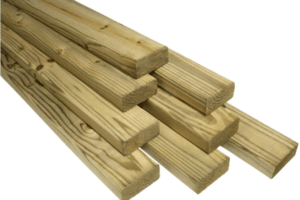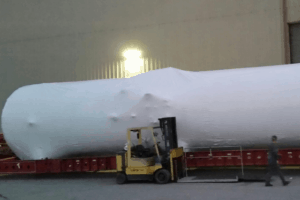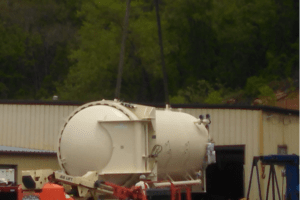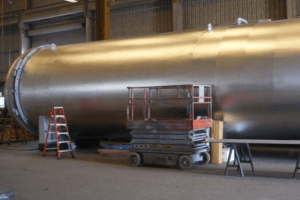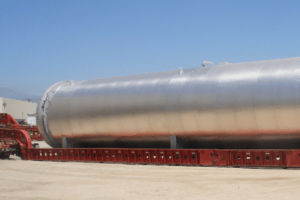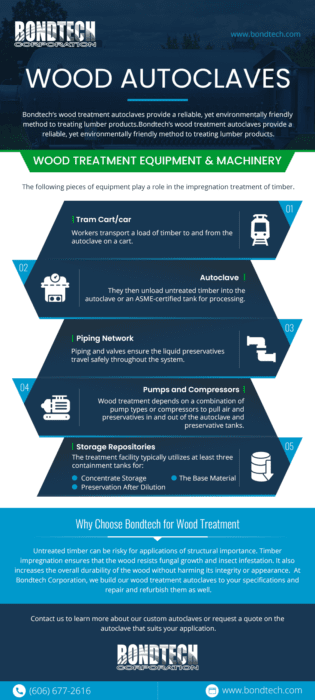Wood has turned into one of the most frequented materials used in industrial applications due to it’s ecological value and changes in lifestyles. Bondtech’s wood treatment autoclave systems is the culmination of lastest industrial trends in quality and efficiency. Using the lastest in process controls including Bondtech’s latest EnVision process control systems, make it possible for saturants to reach the interior of the wood product. Finializing into complte treatment of the lumber introduced and consequently the extention of the life of the lumber product.
Autoclave Systems for Wood Treatment & Timber Impregnation
Timber treatment is necessary to increase the durability and lifespan of wooden material. Water damage, insect infestations, and mold or fungus can otherwise degrade the integrity of wooden structures. Timber impregnation treatment under a vacuum-pressurized autoclave can make the wood resistant to such threats, exposing it to an environmentally friendly treatment process for higher strength while maintaining its structure. An autoclave is often ideal for treating wood for buildings, shutters, and door or window frames. As a premier manufacturer of autoclaves for treating and impregnating timber, Bondtech Corporation can assist you in choosing the right autoclave for your application.
What Is an Autoclave for Wood Treatment?
Autoclaves are machines that provide a pressurized environment within a chamber in which technicians can introduce steam or other solutions at a controlled temperature and pressure to treat objects for various applications. The healthcare industry, for example, frequently employs autoclaves to sterilize instruments and tools. Autoclaves can kill spores, fungi, bacteria, and viruses with heat and pressure by destroying the protein structures within the substances.
The timber impregnation process starts by forming a vacuum within the autoclave to remove air from the wood and generate pressure. The machine injects the untreated wood with a preservative. With the air removed, the preservative can thoroughly soak into the wood and will not harm its structure or appearance. The preservative improves the wood’s resistance to environmental wear, rain, and insect damage while also making the wood last longer. After processing, workers can remove the impregnated wood from the autoclave to dry and begin preparation for shipment.
Wood Treatment Equipment & Machinery
Numerous pieces of equipment go into the impregnation treatment of timber. The following components play a primary role:
- Tram cart/car. Workers transport a load of timber to and from the autoclave on a cart.
- Autoclave. They then unload untreated timber into the autoclave or an ASME-certified tank for processing in a vacuum-pressure environment.
- Piping network. Piping and valves ensure the liquid preservatives travel safely throughout the system from substance storage to the autoclaves using a series of pumps.
- Pumps and compressors. Wood treatment depends on a combination of pump types or compressors to pull air and preservatives in and out of the autoclave and preservative tanks. For example, a vacuum pump begins the process, removing air from the autoclave chamber. Either an air compressor or a pressure pump will then maintain a predetermined pressure during wood preservation. For the actual treatment, a transfer pump delivers a steady supply of preservatives into the autoclave and then back into storage at the end of the process.
- Storage repositories. Preservatives for wood treatment are often concentrated, meaning that workers must dilute them before use. Depending on a preservative’s base of oil or water, a treatment facility typically utilizes at least three containment tanks: one to store the concentrate, one for the base material, and one to contain the preservative after dilution.
At Bondtech, we use advanced EnVision process control systems to ensure that saturants properly travel to the interior of the treated wood for impregnation.
Wood Autoclave Products
Treating wood products within an autoclave effectively prevents their damage and decomposition. With a reliable product strength, treated wood becomes a versatile product for a variety of applications, including:
- Boat dock, walkway, and bulkhead piling
- Commercial lumber
- Decking
- Door frames
- Fencing
- Lumber for building construction
- Railroad cross-ties
- Shutters
- Utility poles
- Window frames
Applications rely on treated wood products to deliver improved longevity and reduce the need to replace them, so autoclave-impregnated wood offers a cost-effective, sturdy, and significantly safer end product.
Why Choose Bondtech for Wood Treatment Autoclaves?
Untreated timber can be risky for applications of structural importance. Timber impregnation ensures that the wood resists fungal growth and insect infestation. It also increases the overall durability of the wood without harming its integrity or appearance.
An autoclave is essential to the wood impregnation treatment process. At Bondtech Corporation, we build our wood treatment autoclaves to your specifications and repair and refurbish them as well. We have been delivering efficient, quality autoclave systems for over 30 years. While the medical industry is a frequent user of autoclaves, our team has also worked with glass lamination, aerospace, wood treatment, and rubber vulcanizing clients. We rely on our experience in various industries to meet your needs and expectations.
Contact us to learn more about our custom autoclaves or request a quote on the autoclave that suits your application.


